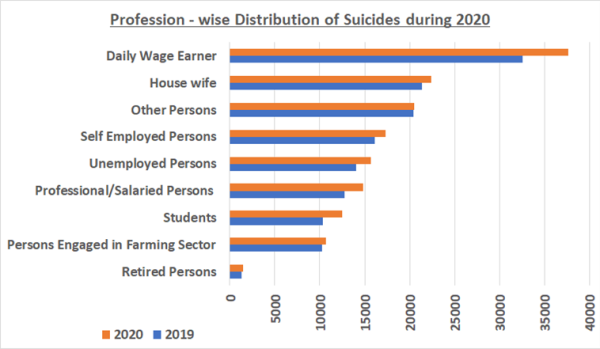Accidental Deaths & Suicides in India Report 2020 : NCRB | 30 Oct 2021
Why in News
Recently, the National Crime Records Bureau (NCRB) released the Accidental Deaths & Suicides in India Report 2020.
Key Points
- Suicide Categories:
- The report divides suicides into nine categories — apart from daily wagers, housewives and people working in the farm sector, the deaths are listed under ‘professionals/salaried persons’, ‘students’, ‘self-employed persons’, ‘retired persons’, and ‘others’.
- NCRB started categorizing daily wagers in its ‘Accidental Deaths & Suicides’ data only in 2014.
- The report divides suicides into nine categories — apart from daily wagers, housewives and people working in the farm sector, the deaths are listed under ‘professionals/salaried persons’, ‘students’, ‘self-employed persons’, ‘retired persons’, and ‘others’.
- Number of Suicides:
- Suicides in India rose 10% from 2019 to an all-time high of 1,53,052 in the pandemic year of 2020.
- The share of daily wage earners among those who died by suicide has doubled between 2014 and 2020, followed by ‘housewives’, self-employed persons, farmers/cultivators and retired persons.
- The professional/salaried persons group registered an increase in suicides.
- The unemployed persons group saw an increase in suicides and their proportion went up slightly from 2019.
- Deaths caused by accidents came down from 2019 and the number is the lowest since 2010.
- The share of students in the total suicides has been rising steadily over the years and has now reached the highest level since 1995.
- State-Wise Analysis:
- The worst among States continues to be Maharashtra, with 4,006 suicides in the farm sector, including a 15% increase in farm worker suicides.
- Other States with a poor record include Karnataka, Andhra Pradesh and Madhya Pradesh.
- Cause-Wise Analysis:
- Among causes of suicide that make up at least a percent of such deaths:
- Poverty and unemployment registered the biggest increase.
- Drug abuse or alcohol addiction, illness, and family problems come next.
- Although students have registered an increase in deaths by suicide it was likely related to relatively longer-term prospects (perhaps inability to continue education) than exams.
- Among causes of suicide that make up at least a percent of such deaths:
- Related Initiatives:
- Mental Healthcare Act, 2017: It aims to provide mental healthcare services for persons with mental illness.
- KIRAN: The Ministry of Social Justice and Empowerment has launched a 24/7 toll-free helpline to provide support to people facing anxiety, stress, depression, suicidal thoughts and other mental health concerns.
- Manodarpan Initiative: It is an initiative of the Ministry of Education under Atmanirbhar Bharat Abhiyan. It is aimed to provide psychosocial support to students, family members and teachers for their mental health and well-being during the times of Covid-19.
National Crime Records Bureau
- NCRB, headquartered in New Delhi, was set-up in 1986 under the Ministry of Home Affairs to function as a repository of information on crime and criminals so as to assist the investigators in linking crime to the perpetrators.
- It was set up based on the recommendations of the National Police Commission (1977-1981) and the MHA’s Task Force (1985).
- NCRB brings out the annual comprehensive statistics of crime across the country (‘Crime in India’ report).
- Having been published since 1953, the report serves as a crucial tool in understanding the law and order situation across the country.
- The inaugural function of the 2nd CCTNS Hackathon and Cyber Challenge 2020-21 of NCRB was held in New Delhi.

